PoW Camp
1914 – 1918
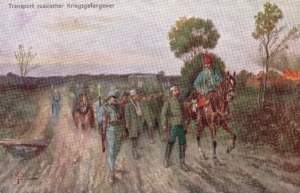
Genre postcard depicting the transport of Russian prisoners of war.
After the outbreak of the WWI, waves of transports with PoW started flowing into Milovice, for whom 3 barrack camps were set up on the grounds of the military training camp. During the conflict, up to 48,000 soldiers and civilians were interned here. The largest group were Italians, followed by Russians, Serbs and other nationalities. The main camp was located east of Benátecká Vrutice. It consisted of 103 wooden barracks, which included a delousing station, a morgue, and an Orthodox prayer room. The entire camp was surrounded by a triple barbed wire fence, with guard towers in front of it. The administration of the prison camp was led by General Steiner, Colonel Keil and Colonel Haelberth.
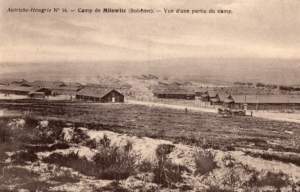
„Rows of long wooden houses were covered with black cardboard. A large black village full of mysterious sadness was created.“ (Chronicle of the Benátecká Vrutice)
The living conditions of the PoWs were horrendous. They died in masses because of infectious diseases, from exhaustion and lack of food. Under the strict supervision of Hungarian soldiers, they had to work in the fields, build roads and participate in regulating the Elbe. The road from Lipník to Jiřice still carries the name of the Russian Road to this day. The prisoners who worked for local farmers or in various workshops fared better.
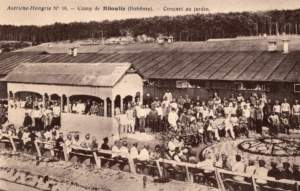
When an International Red Cross commission arrived in Milovice, its leader asked about the cause of the high mortality rate among prisoners. The camp doctor reportedly replied: „Many medicines have been invented for various diseases, but there is no medicine for hunger.“
The life of the PoW revolved around food. The daily portion of food continuously got smaller. At the end of the war, they were only given tea made from 2 grams of blackberry leaves for breakfast, and if they were lucky, 15 grams of sugar. For lunch, they were given boiled sugar or fodder beets. Thin legume soup for dinner. The menu was occasionally spiced up with stinking dried cod or horse meat broth. The Italians in Camp III fared even worse. It is no wonder that they often tried to conceal the deaths of their comrades in order to share their rations.
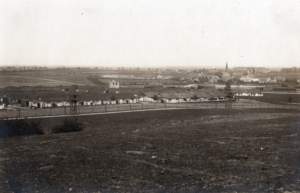
After Italy entered the war, there was an influx of new PoWs, and Camp III with 46 barracks was built west of Milovice.
Hunger forced the prisoners to be inventive. They rummaged through garbage dumps and made various things from the materials they found, which they exchanged with the civilian population for food. They spun threads from pieces of bed sheets, wove baskets from straw, and carved various toys, snuff boxes, and many other things from wood. Everything was done secretly. Civilians were strictly forbidden to give anything to the prisoners, lest they wouldn’t poison them. Parents and relatives also tried to improve the condition of the captured soldiers, sending them food parcels. However, the camp administration usually did not give them out.
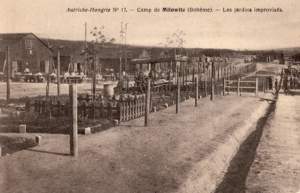
The main prison camp near Benátecká Vrutice, which the locals simply called „the camp (laager)“.
Did you know that…? Colonel Adolf Halbaerth’s wife was the writer Gabriela Preissová (1862–1946), author of the short stories Její pastorkyně and Gazdina roba. At her urging, he tried to improve the living conditions of the prisoners, and as punishment he was transferred to Šamorín.
